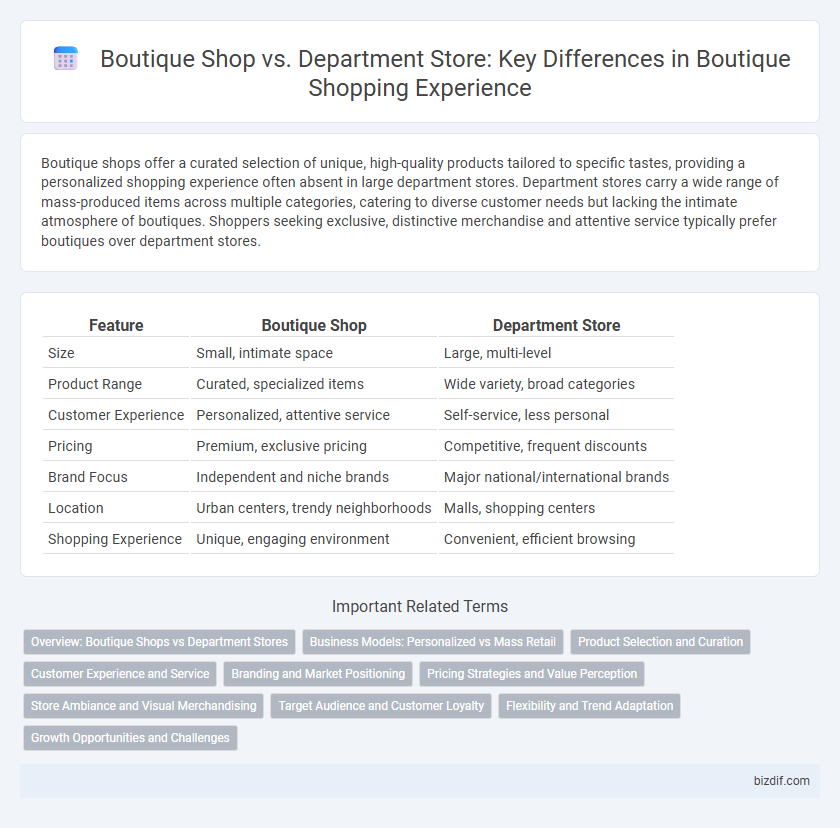Boutique shops offer a curated selection of unique, high-quality products tailored to specific tastes, providing a personalized shopping experience often absent in large department stores. Department stores carry a wide range of mass-produced items across multiple categories, catering to diverse customer needs but lacking the intimate atmosphere of boutiques. Shoppers seeking exclusive, distinctive merchandise and attentive service typically prefer boutiques over department stores.
Table of Comparison
| Feature | Boutique Shop | Department Store |
|---|---|---|
| Size | Small, intimate space | Large, multi-level |
| Product Range | Curated, specialized items | Wide variety, broad categories |
| Customer Experience | Personalized, attentive service | Self-service, less personal |
| Pricing | Premium, exclusive pricing | Competitive, frequent discounts |
| Brand Focus | Independent and niche brands | Major national/international brands |
| Location | Urban centers, trendy neighborhoods | Malls, shopping centers |
| Shopping Experience | Unique, engaging environment | Convenient, efficient browsing |
Overview: Boutique Shops vs Department Stores
Boutique shops specialize in curated, unique collections offering personalized customer experiences and niche fashion or products, often featuring exclusive or artisanal brands. Department stores provide a wide range of merchandise across multiple categories under one roof, emphasizing convenience, variety, and competitive pricing. Both retail formats cater to different shopping preferences, with boutiques focusing on individuality and department stores on breadth and accessibility.
Business Models: Personalized vs Mass Retail
Boutique shops emphasize personalized customer experiences by offering curated, unique products that cater to specific tastes, fostering strong brand loyalty through tailored service. Department stores operate on a mass retail business model, providing a wide variety of products across multiple categories to appeal to a broad customer base and maximize sales volume. The boutique model leverages exclusivity and niche marketing, while department stores focus on scale, convenience, and competitive pricing.
Product Selection and Curation
Boutique shops offer a highly curated product selection, focusing on unique, artisanal, or niche items that reflect specific styles or trends, providing a personalized shopping experience. Department stores feature a broad range of products across multiple categories, including clothing, accessories, and home goods, catering to a wide audience with mass-market brands. The curated inventory of boutiques often emphasizes quality and exclusivity, while department stores prioritize variety and convenience.
Customer Experience and Service
Boutique shops offer a personalized customer experience with curated product selections tailored to niche markets, enhancing individual attention and unique service. Department stores provide a broad range of products under one roof, prioritizing convenience but often at the expense of intimate customer interactions. The boutique environment fosters stronger brand loyalty through exclusive, high-touch service, distinguishing it from the more transactional experience typical in department stores.
Branding and Market Positioning
Boutique shops emphasize personalized branding and exclusive product selections to create a distinct market position targeting niche customer segments. Department stores prioritize broad branding strategies with diverse product offerings aimed at mass-market appeal and high foot traffic. Boutique branding leverages unique ambiance and curated experiences, while department stores rely on brand recognition and economy of scale.
Pricing Strategies and Value Perception
Boutique shops often implement premium pricing strategies to emphasize exclusivity, personalized service, and unique product offerings, enhancing the perceived value for niche customers. In contrast, department stores leverage competitive pricing and volume discounts to attract a broad audience, prioritizing affordability and convenience over exclusivity. The perceived value in boutiques centers on quality and individuality, while department stores emphasize accessibility and variety.
Store Ambiance and Visual Merchandising
Boutique shops create an intimate store ambiance through personalized layouts and curated decor, enhancing customer experience with unique, themed visual merchandising. Department stores utilize expansive floor plans and standardized displays to maximize product variety, relying on broad visual merchandising strategies to attract diverse shoppers. The contrasting ambiance and merchandising styles influence consumer behavior by fostering exclusivity in boutiques and convenience in department stores.
Target Audience and Customer Loyalty
Boutique shops target niche markets, appealing to customers who seek unique, personalized products and exclusive shopping experiences, which fosters strong customer loyalty through tailored service and curated selections. Department stores attract a broad audience with diverse product ranges and competitive pricing, but their customer loyalty is often lower due to less personalized interactions and a focus on volume. The specialized focus of boutiques creates higher customer retention rates as shoppers value the distinctiveness and personal attention unavailable in larger department stores.
Flexibility and Trend Adaptation
Boutique shops excel in flexibility by offering unique, curated selections that quickly adapt to emerging fashion trends, providing personalized shopping experiences. Department stores, constrained by larger inventories and standardized layouts, often face delays in reflecting the latest trends across multiple departments. This agility enables boutiques to attract trend-conscious customers seeking exclusive and timely styles unavailable in larger retail chains.
Growth Opportunities and Challenges
Boutique shops offer personalized customer experiences and niche product selections that drive growth in specialized markets, but face challenges in scaling operations and competing with larger retailers. Department stores benefit from broader product ranges and economies of scale, creating growth opportunities through diverse customer bases and bulk purchasing power, yet they struggle with adapting to rapidly changing consumer preferences and online competition. Both retail formats must innovate by leveraging digital tools and enhancing customer engagement to sustain growth despite market challenges.
Boutique Shop vs Department Store Infographic

 bizdif.com
bizdif.com